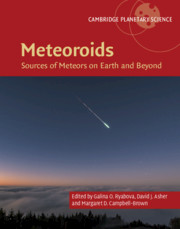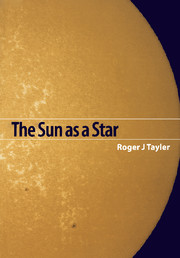Refine listing
Actions for selected content:
17000 results
Part V - Hazard
-
- Book:
- Meteoroids
- Published online:
- 04 October 2019
- Print publication:
- 10 October 2019, pp 253-254
-
- Chapter
- Export citation
Part II - Meteor Observations on the Earth
-
- Book:
- Meteoroids
- Published online:
- 04 October 2019
- Print publication:
- 10 October 2019, pp 63-64
-
- Chapter
- Export citation
Color Plates
-
- Book:
- Meteoroids
- Published online:
- 04 October 2019
- Print publication:
- 10 October 2019, pp 307-322
-
- Chapter
- Export citation
Preface
-
- Book:
- Meteoroids
- Published online:
- 04 October 2019
- Print publication:
- 10 October 2019, pp xiii-xiii
-
- Chapter
- Export citation
Contents
-
- Book:
- Meteoroids
- Published online:
- 04 October 2019
- Print publication:
- 10 October 2019, pp vii-viii
-
- Chapter
- Export citation
List of Contributors
-
- Book:
- Meteoroids
- Published online:
- 04 October 2019
- Print publication:
- 10 October 2019, pp ix-xii
-
- Chapter
- Export citation
11 - The Meteoroid Impact Hazard for Spacecraft
- from Part V - Hazard
-
- Book:
- Meteoroids
- Published online:
- 04 October 2019
- Print publication:
- 10 October 2019, pp 255-274
-
- Chapter
- Export citation
Part I - Meteor Physics
-
- Book:
- Meteoroids
- Published online:
- 04 October 2019
- Print publication:
- 10 October 2019, pp 7-8
-
- Chapter
- Export citation
Part IV - Interrelations
-
- Book:
- Meteoroids
- Published online:
- 04 October 2019
- Print publication:
- 10 October 2019, pp 159-160
-
- Chapter
- Export citation

Meteoroids
- Sources of Meteors on Earth and Beyond
-
- Published online:
- 04 October 2019
- Print publication:
- 10 October 2019

The Sun as a Star
-
- Published online:
- 13 September 2019
- Print publication:
- 28 October 1996
-
- Textbook
- Export citation
Contents
-
- Book:
- The Quest for a Universal Theory of Life
- Published online:
- 05 September 2019
- Print publication:
- 12 September 2019, pp ix-xi
-
- Chapter
- Export citation
2 - Why Life Cannot Be Defined
-
- Book:
- The Quest for a Universal Theory of Life
- Published online:
- 05 September 2019
- Print publication:
- 12 September 2019, pp 33-62
-
- Chapter
- Export citation
Index
-
- Book:
- The Quest for a Universal Theory of Life
- Published online:
- 05 September 2019
- Print publication:
- 12 September 2019, pp 243-246
-
- Chapter
- Export citation
1 - The Enduring Legacy of Aristotle: The Battle over Life as Self-Organization or (Genetic-Based) Reproduction
-
- Book:
- The Quest for a Universal Theory of Life
- Published online:
- 05 September 2019
- Print publication:
- 12 September 2019, pp 8-32
-
- Chapter
- Export citation
Dedication
-
- Book:
- The Quest for a Universal Theory of Life
- Published online:
- 05 September 2019
- Print publication:
- 12 September 2019, pp vii-viii
-
- Chapter
- Export citation
5 - Challenges for a Universal Theory of Life
-
- Book:
- The Quest for a Universal Theory of Life
- Published online:
- 05 September 2019
- Print publication:
- 12 September 2019, pp 105-131
-
- Chapter
- Export citation
Introduction
-
- Book:
- The Quest for a Universal Theory of Life
- Published online:
- 05 September 2019
- Print publication:
- 12 September 2019, pp 1-7
-
- Chapter
- Export citation
9 - A Shadow Biosphere: Alien Microbes on Earth?
-
- Book:
- The Quest for a Universal Theory of Life
- Published online:
- 05 September 2019
- Print publication:
- 12 September 2019, pp 195-216
-
- Chapter
- Export citation
Copyright page
-
- Book:
- The Quest for a Universal Theory of Life
- Published online:
- 05 September 2019
- Print publication:
- 12 September 2019, pp vi-vi
-
- Chapter
- Export citation
